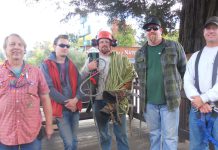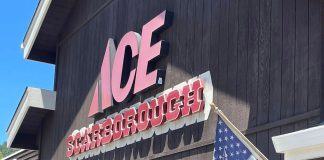As the Great Depression waned and the first touring Chevvies and Deusies roared across Santa Cruz Mountains to the Pacific, Scotts Valley was right where it needed to be: perfectly placed to greet those pioneer motor-venturers with a hot drink at Camp Evers, a restock of provisions and, by all accounts, a roaring foxtrot. In short, our little rest stop on the California Trail began its own adventurous economic journey out of the Great Depression into the brave new mobile world.
But economies are based on manufacturing, building and farming things, right? Not just welcoming day-trippers, eating lunch and dancing foxtrots? Well, not quite.
Economists have been kind enough to give us some useful definitions: primary and secondary economies are based on raw materials (wood, iron and corn) and manufacturing (bridges, steel and corndogs), but tertiary economies are driven by service and knowledge-based activities like managing our money, rolling our sushi rolls, teaching us to foxtrot and Zumba and, very importantly, developing new technologies or wowing visitors with great local products, services and entertainment.
Hairdressers are tertiary. Spas and wellness centers, local artisan stores, Cambodian restaurants and start-ups — yes R&D-based high-tech startups — are tertiary economic engines! Doctors, therapists and chiropractors are tertiary, carpet and lighting specialists, sprinkler experts, painters, roofers, Rolfers and reindeer, and yes, even Santa (and his village) was one of our tertiary economic founding fathers.
So, it’s almost a century since Camp Evers, and as we head out of the Great Recession in our lifetime, the questions we need to ask as a community are as similar and vital today as they were then: What is the future of our city, and how do we welcome this brave, new mobile world? Do we become a Los-Gatos-by-the-Sea, or a Stockton? A renowned destination on the road to the Pacific, or a bypass town?
Today, our mobility is defined not just by our cars, but by our ever-connected electronic devices. Welcoming inventive startups, creative artists, retailers, restaurateurs and, of course, visitors can be done in a whole new way.
Are we ready for this? Are our leaders? Ready for the rapid combination of economic incentives, targeted business development, city renewal and political leadership that’s needed to drive success? Will we have a beautiful town center attracting the foot traffic needed for our tertiary economy to thrive, or will we still have a field? Will we lure our fair share of the thousands of new startups formed in Silicon Valley every year with the right incentives and economic development practices, or will we continue to wave them goodbye, like Borland, Aviza and Seagate?
Most critically, do we understand what it means if we don’t embrace this challenge, what the loss of a Seagate or a Target really means to our city, our real estate and our community — hundreds of people no longer eating lunch, dry-cleaning shirts or polishing teeth?
This is a critical point in our history as a community, a tipping point for Scotts Valley. We all have a story of opportunity and adventure that brought us to this beautiful valley. The question now is, What story will we tell our children, and what legacy will we leave?
Simon McElrea is a businessman, freelance contributor and Scotts Valley resident. He is dedicated to startup business creation and economic development.











